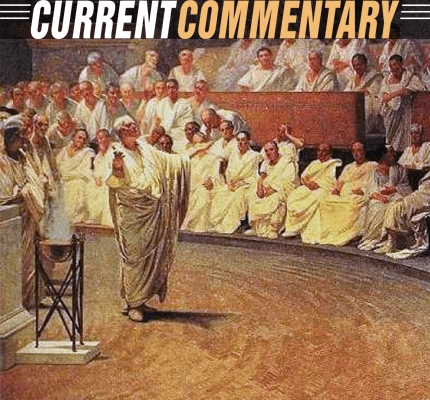
Why Classical Theories of Rhetoric Matter in the Trump Presidency
By Rick Cherwitz, Ph.D.
I often hear people claim that theories of rhetoric, particularly those dating back to ancient Greece and Rome, have little practical value in our contemporary world. I take issue with this assertion. As evidence, let me suggest that part of what is happening with allegations against President Donald Trump in 2017 are best explained by recalling the theory of “stasis” first advanced by Roman rhetoricians thousands of years ago.
As a college professor who studies and teaches rhetoric, it never ceases to amaze me how many of the ways we argue about topics in politics and law have their roots in Antiquity—specifically, in classical theories of rhetoric. While we think our discourse today is unique to the times and circumstances in which we live, the reality is that patterns of thinking and talking are inherent in the human condition and therefore may be time invariant.
Case in point: Every semester, I teach an undergraduate course in Argumentation & Advocacy, a class comprising dozens of students who eventually become lawyers. In this course, I present the Roman concept of “stasis”—a theory refined by Cicero, Quintilian, and Hermogenes that delineated all of the issues attorneys in Roman times drew upon to determine whether someone was guilty.
As I tell my students, while the Romans couldn’t have predicted the specific content about which we argue in the 21st century, their notion of stasis is both applicable and informative, and perfectly anticipated how we argue today.
Consider the three major points of stasis detailed by the Romans. First are “questions of fact”—what the Romans called “an sit.” This question asks: Did the accused commit the act or do the deed? This is a factual question, not a legal one. Second are “questions of definition or interpretation”—what the Romans called “quid sit.” Here attorneys ask: Does the act or deed constitute and meet the definition of the crime? This is a legal question. Finally are “questions of quality or justification”—what the Romans called “quale sit.” Put differently, is there partial or absolute justification explaining why the accused may have committed the deed?
The Romans made clear that several sub-issues help answer the first point of stasis, questions of fact. For example, is there circumstantial evidence (the place, time, and duration of the act) or motives that implicate the accused? In addition, is there past proof (what the accused did or said prior to the act), contemporaneous proof (what was done or said simultaneous to the act) or subsequent proof (evidence such as blood, finger prints, etc. obtained after the act occurred) suggesting the accused did the deed?
But there is one sub-issue I find particularly enlightening in 2017. It was called “argument from consequence.” Roman lawyers often asked: Does the accused person’s behavior show signs or consequences of guilt? In the case of recent allegations made about President Donald Trump, argument from consequence is telling and a paradigmatic example of the applicability of the Roman theory of stasis.
In the past few months, Trump has admitted that he fired FBI director James Comey because of the Russian investigation. His tweets have included numerous examples of inconsistency where Trump contradicted what members of his own administration have said.
Very recent revelations are perhaps the most curious. Trump asked his advisers about the rules pertaining to presidential pardons and doubled down on his efforts to undermine the investigation by the special prosecutor. Although some find all of this innocuous, many people wonder whether Trump’s actions and words expose a person who did things that are wrong and perhaps illegal—someone who shows the “consequences” of guilt.
Many legal observers and members of the media reasonably ask: If Trump isn’t guilty of wrongdoing and subsequently of covering it up, why would he say and do the things he does? After all, as the Romans knew, only a guilty person would behave that way.
To be clear, I am not arguing that this is a prima facie case for President Trump’s guilt. But it certainly is relevant and probative. At minimum, it indicates why we should remind ourselves and our students that the ways we think and argue are deeply rooted in the human condition and are explained by the rhetoricians who lived thousands of years ago.
References:
- Otto Alvin Loeb Dieter, “Stasis,” Speech Monographs, 17 (1950), 345-369.
- Ray Nadeau, “Hermogenes’ On Stases: A Translation with an Introduction and Notes,” Speech Monographs, 31 (1964), 361-424.


